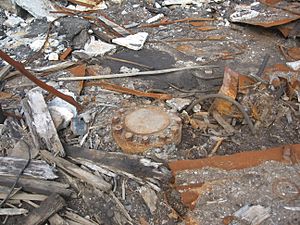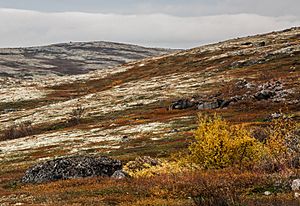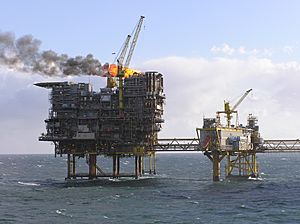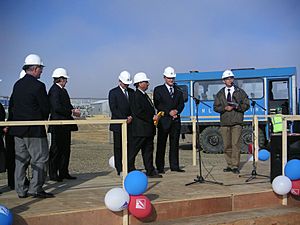Kola Superdeep Borehole facts for kids
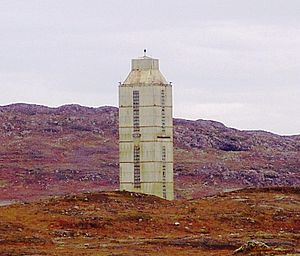
Superstructure of the Kola Superdeep Borehole, 2007
|
|
| Location | |
|---|---|
| Location | Pechengsky District |
| Murmansk Oblast | |
| Country | Russia |
| Coordinates | 69°23′47″N 30°36′36″E / 69.3965°N 30.6100°E |
| Greatest depth | 12,262 metres (40,230 ft; 7.619 mi) |
| History | |
| Opened | 1965 |
| Active |
|
| Closed | 1995 |
The Kola Superdeep Borehole is the result of a scientific drilling project of the Soviet Union in the Pechengsky District, on the Kola Peninsula. The project attempted to drill as deep as possible into the Earth's crust. Drilling began on 24 May 1970.
Boreholes were drilled by branching from a central hole. The deepest, SG-3, reached 12,262 metres (40,230 ft; 7.619 mi) in 1989 and is the deepest artificial point on Earth.
The project ended in 1995 due to the dissolution of the Soviet Union and the site has since been abandoned. The ruins of the site, however, are frequently visited by curious sightseers.
Drilling
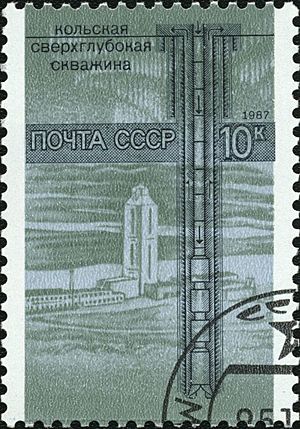
The main target depth was set at 15,000 m (49,000 ft). On 6 June 1979, the world depth record held by the Bertha Rogers hole in Washita County, Oklahoma, United States, at 9,583 m (31,440 ft) was broken.
In 1983, the drill passed 12,000 m (39,000 ft), and drilling was stopped for about a year for numerous scientific and celebratory visits to the site.
The hole reached 12,262 m (40,230 ft) in 1989. In that year, the hole depth was expected to reach 13,500 m (44,300 ft) by the end of 1990 and 15,000 m (49,000 ft) by 1993. Because of higher-than-expected temperatures at this depth and location, 180 °C (356 °F) instead of the expected 100 °C (212 °F), drilling deeper was deemed unfeasible and the drilling was stopped in 1992.
Research
The Kola borehole penetrated about a third of the way through the Baltic Shield continental crust, estimated to be around 35 kilometres (22 mi) deep, reaching Archaean rocks at the bottom. The project has been a site of extensive geophysical studies.
Microscopic plankton fossils were found 6 kilometers (4 mi) below the surface.
Another unexpected discovery was a large quantity of hydrogen gas. The mud that flowed out of the hole was described as "boiling" with hydrogen.
Similar projects
- The United States had embarked on a similar project in 1957, dubbed Project Mohole, which was intended to penetrate the shallow crust under the Pacific Ocean off Mexico. After some initial drilling, the project was abandoned in 1966 because of a lack of funding. This program inspired the great successes of the Ocean Drilling Program, Integrated Ocean Drilling Program and the present International Ocean Discovery Program.
- The KTB superdeep borehole (German Continental Deep Drilling Programme, 1987–1995) at Windischeschenbach in northern Bavaria was drilled to a depth of 9,101 m (29,859 ft) reaching temperatures of more than 260 °C (500 °F). Its ambitious measuring program used high-temperature logging tools that were upgraded specifically for KTB.
Records
The Kola Superdeep Borehole was the longest and deepest borehole in the world for nearly 20 years. In May 2008, a new record for borehole length was established by the extended-reach drilling (ERD) well BD-04A, which was drilled by Transocean for Maersk Oil in the Al Shaheen Oil Field in Qatar. Transocean drilled a total length of 12,289 m (40,318 ft), with a record horizontal reach of 10,902 m (35,768 ft) in only 36 days.
On 28 January 2011, Exxon Neftegas Ltd., operator of the Sakhalin-I project, drilled the world's longest extended-reach well offshore on the Russian island of Sakhalin. It has surpassed the length of both the Al Shaheen well and the Kola borehole. The Odoptu OP-11 well reached a measured total length of 12,345 m (40,502 ft) and a horizontal displacement of 11,475 m (37,648 ft). Exxon Neftegas completed the well in 60 days.
On 27 August 2012, Exxon Neftegas Ltd beat its own record by completing the Z-44 Chayvo well. This ERD well reached a measured total length of 12,376 metres (40,604 ft).
In terms of depth below the surface, the Kola Superdeep Borehole SG-3 retains the world record at 12,262 metres (40,230 ft) in 1989 and is still the deepest artificial point on Earth.
Related pages
See also
 In Spanish: Pozo superprofundo de Kola para niños
In Spanish: Pozo superprofundo de Kola para niños


